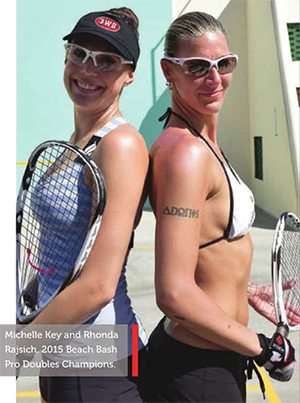|
|

Think Summer Sun and Outdoor Racquetball
By Steve Crandall
Vice President, Sales & Marketing
Ashaway Racket Strings
 |
I don't know if it's the people I've been talking to lately or the fact that, as I write, it's been snowing steadily here in New England for the last month, but I keep thinking about outdoor racquetball. I see myself rallying out under a hot sun and a clear blue sky. The courts are right off the beach and a cool ocean breeze is wafting through. Hordes of people are wandering by, music is playing, the scent of hot dogs and mustard is in the air… I'm sure you get the picture.
Now, I must confess I have not actually played outdoor racquetball. Yet. But the sport is growing by leaps and bounds-especially in terms of tournaments-and it's definitely on my to-do list. So to prepare myself (and feed my summer sun fantasy) I thought I'd talk about the game with a couple of experts, Hall of Famers Cliff Swain and Jacqueline Paraiso.
Not surprisingly both say they love the game but claim that it's surprisingly different from its indoor cousin, despite having the same rules. "Oh, it's crazy different," said many-time World Doubles Champion Jacqueline. "For one, you don't have all the walls to work with so you really have to be good at moving laterally and controlling the ball. If it hits to the back, you don't have the back wall as a cushion. It's a tougher game for that reason, if you ask me."
Cliff has been very active in outdoor racquetball, winning the 2014 World Outdoor Racquetball (WOR) Pro doubles division with partner Josh Tucker. He says the game is "more straightforward," especially the one wall version invented in 1910 and still popular in New York City. "You can hit the ball hard and up the middle. The best shot on almost all outdoor courts is a ball two to five feet high and right up the middle. That's the worst indoor shot. And the reason outdoor players struggle indoors is because it's easier to pick on the back hand than it is outdoors."
While indoor courts are a standard 20' x 40' with sidewalls and ceilings, outdoor courts are more varied. Jacqueline plays a lot at Marina Park in Huntington Beach, CA, which she says, "is three feet longer and six feet wider than a regular court, so you're covering a lot more ground. But some courts are smaller. Some courts have a partial ceiling in the front, but many don't have any. The sidewalls can go back to the service box, or they can angle off before the service box, so when you're used to serving high off the front or side wall, you don't have that opportunity."
Cliff started playing outdoor at the L Street Beach Court in South Boston, which has a long wall of 110 ft. "Having even a partial ceiling makes it very difficult to hit it out of the court. But if the ceiling's not there you can hit it real high and hitting it out 110 feet is no problem. I think that's what makes L Street the best doubles court in the world."
Cliff and Jacqueline both compared outdoor to tennis and golf, where you not only have the weather to contend with but differing course configurations, and different surfaces as well. "You used to see different tennis players excel on different surfaces," said Cliff. "But what's been happening with tennis and outdoor racquetball is that players are learning to play on all surfaces. Before, you saw outdoor players being much better at one wall or long wall, whereas indoor players would all struggle outdoors. Now I think we're starting to see that the best players are getting good on all outdoor surfaces."
The growing popularity of outdoor is another thing both players commented on. "I think it's definitely more appealing for an audience," said Jacqueline. "They can see more, get more involved, interact with the players more. It's like taking a tennis match and putting it in a racquetball court. You have the same atmosphere and feeling."
Cliff likes the fact that, "it's out in the sun and there are usually lots of people around, and music playing. Plus, there are a lot of free public courts. The crowds are bigger at tournaments. I think outdoor helps promote indoor as well. So that's good for everybody."
"It's just more fun!" Jacqueline added. "The atmosphere is completely different outdoors. You've got people hanging out in their lawn chairs!"
As for stringing, both agree that control is key to the outdoor game. "Basically you have limited side walls and no back walls," said Jacqueline. "So you've got to control the game better and keep the ball in the court. If you hit an angled pass shot, you'd better keep it nice and controlled because if you widen that angle just a little bit and it bounces outside that line, then you lose that rally.
Jacqueline swears by Ashaway's red PowerKill® 17 these days because she can, "hit that ball a lot harder and control it at the same time. I string racquets as well," she added, "and I just can't keep the PowerKill in stock. Everybody wants it!" For outdoor she also strings the crosses a bit tighter to improve control.
Cliff also uses Ashaway PowerKill 17 red, strung at precisely 33.5 lbs. to ensure control. "I always get my racquets strung at the same tension at the same time and on the same machine," he said. "Then you don't give away points. People spend hundreds of dollars on racquets and yet they don't realize the importance, not only of having a good string, but of having that level of consistency in the stringing."
I'm going to keep these tips in mind and look for someplace hot and sunny!
|